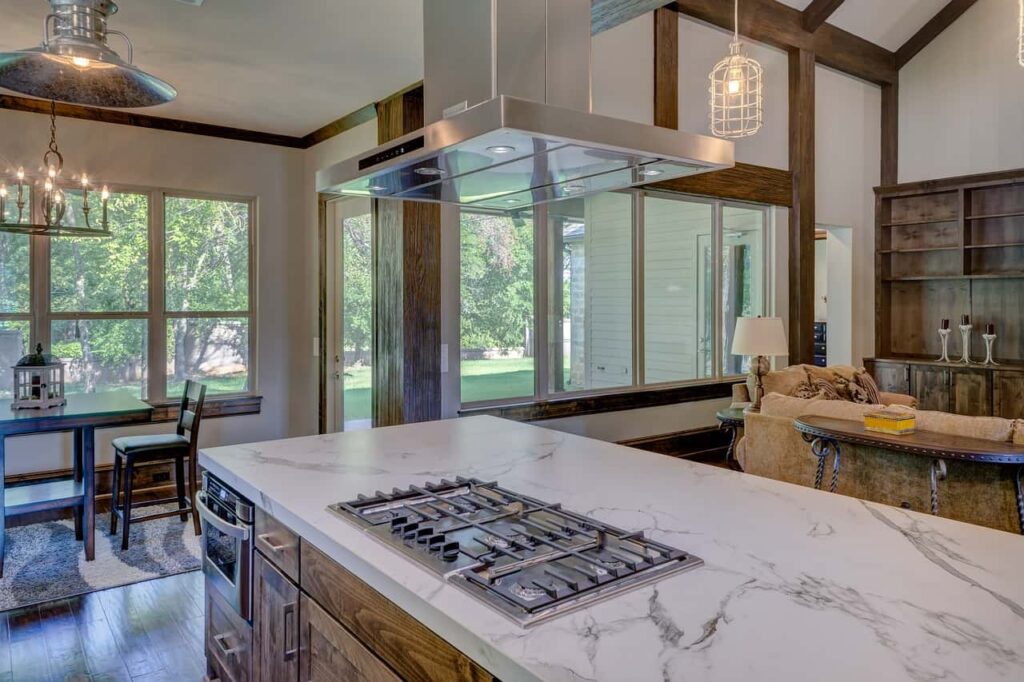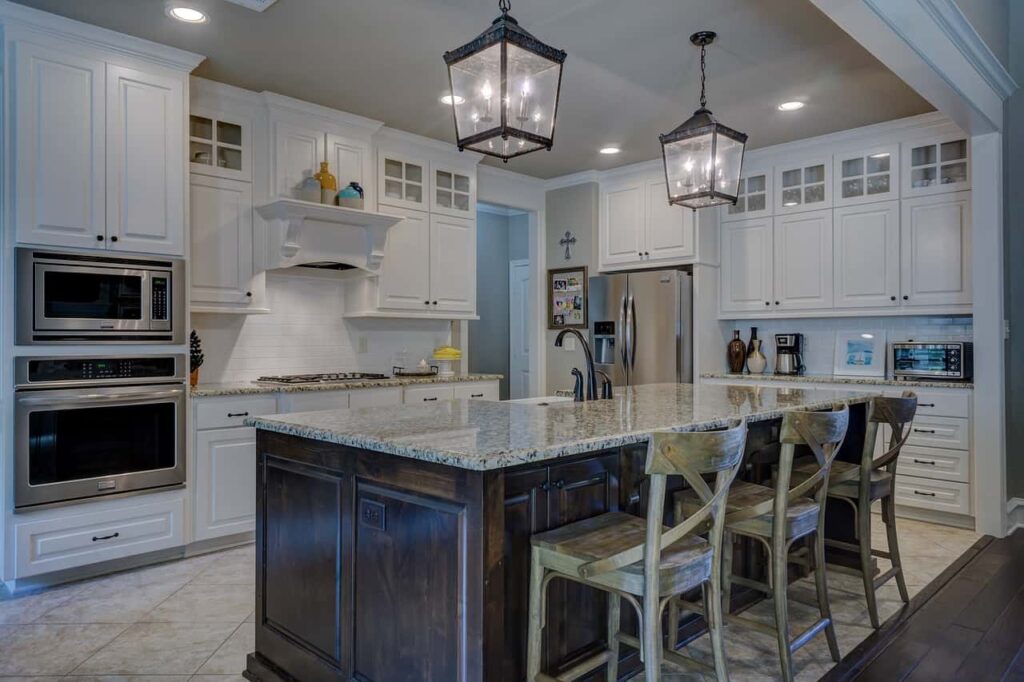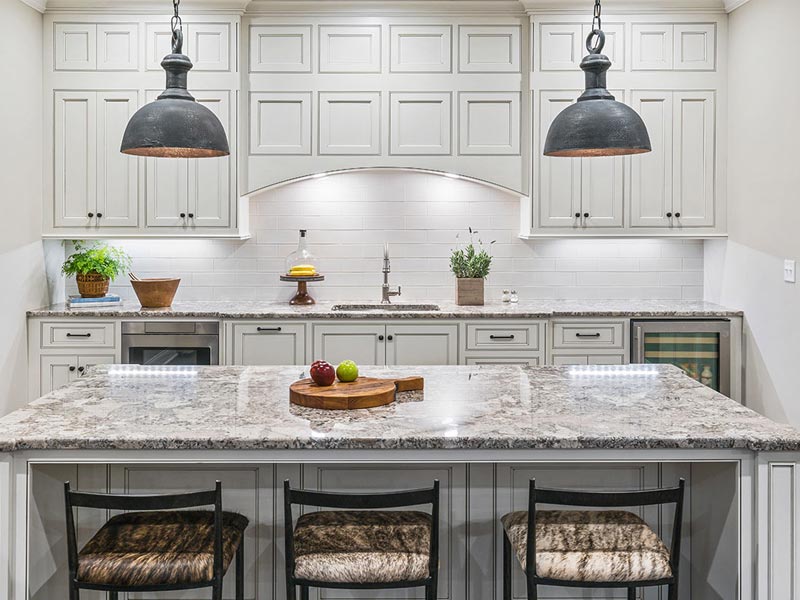In recent years, kitchen islands have become a highly sought-after feature in home remodels in Nashville and people often ask, “is a kitchen island right for my house?” At Nashville Bath & Kitchen, we’ve worked with hundreds of homeowners in Middle Tennessee to help them decide whether a kitchen island makes sense for their space, needs, and lifestyle. While the idea of extra storage, more counter space, and a stylish focal point is appealing, a kitchen island isn’t a one-size-fits-all solution.
This article will walk you through the pros and cons of kitchen islands, the factors to consider before installing one, design inspirations tailored to Nashville homes, and when an island might not be the best choice. If you’re thinking about a kitchen remodel in the Nashville area, read on. This guide will help you make an informed decision that aligns with your home’s layout and your family’s daily routine.
The Benefits of Adding a Kitchen Island
One of the biggest perks of adding a kitchen island is the boost in functionality it provides. If you’re prepping for dinner, baking with the kids, or just trying to stay organized, a kitchen island adds valuable counter space that helps streamline your workflow. In many Nashville kitchens, where counter space can be limited by older layouts or galley-style configurations, an island can significantly improve the usability of the space.

Another major benefit is the added seating a kitchen island can provide. It’s perfect for casual meals, morning coffee, or entertaining guests during a party or holiday gathering. In fact, we often hear from clients that their island becomes the most used “table” in the house. Especially in open-concept homes, an island helps bridge the kitchen and living areas, making it a central hub for both cooking and conversation.
Storage is another key reason homeowners opt for kitchen islands. Custom islands can include deep drawers for pots and pans, built-in trash bins, spice racks, or even wine fridges. In a Nashville home where every square foot matters, having smart storage solutions in your island can free up your main cabinetry for other needs.
Lastly, islands are extremely versatile. They’re not just for cooking. Many families use them as homework stations, work-from-home desks, or serving buffets during gatherings. The island often becomes the heart of the kitchen, both practically and socially.
Considerations Before Installing a Kitchen Island
While kitchen islands offer many benefits, they also come with specific space requirements that shouldn’t be overlooked. To function well, an island needs ample clearance on all sides—generally a minimum of 36 to 42 inches. This ensures easy movement and prevents bottlenecks, especially if you have multiple cooks or foot traffic from other rooms. In compact kitchens, squeezing in an island may actually hinder the layout rather than improve it.
The existing layout and style of your home also play a major role. Many Nashville homes—especially those in older neighborhoods like Sylvan Park or East Nashville—have more segmented layouts that don’t easily accommodate an island without major structural changes. On the other hand, newer homes in areas like Franklin or Mt. Juliet often come with open-concept designs that are ideal for incorporating an island.

Budget is another important factor. Installing a kitchen island isn’t just about cabinetry and countertops. If you want to include a sink, dishwasher, or cooktop in the island, you’ll need to consider plumbing, electrical, and possibly gas line rerouting. These additions can significantly raise the cost of your remodel, so it’s essential to understand what features you really need versus what’s nice to have.
Functionality should guide your decision-making. Think about how you’ll use the island. Do you need seating for four? Do you want to incorporate appliances or keep it strictly for prep work? Will it serve as a visual centerpiece? By answering these questions, you can work with your designer to build an island that serves both your aesthetic and functional goals.
Design Inspirations for Nashville Kitchens
The design of your kitchen island should complement the overall style of your home, and there are plenty of Nashville-specific trends to draw inspiration from. One of the most popular looks right now is the farmhouse-style island, often featuring shiplap paneling, distressed finishes, and butcher block countertops. These elements nod to Southern charm and work beautifully in older homes or remodels that embrace a rustic aesthetic.
For those seeking a more modern or upscale vibe, waterfall countertops are an eye-catching choice. Typically made from quartz or marble, these countertops extend down the sides of the island to create a sleek, continuous surface. They’re especially popular in high-end remodels in neighborhoods like Green Hills or Belle Meade. Click here to browse countertop materials.
Two-tone cabinetry is another hot trend. For instance, pairing a navy blue or forest green island with white perimeter cabinets can create striking visual contrast. This is a great way to make your island a true focal point without overwhelming the space. We’ve used this approach in several recent projects across Nashville and received great feedback from homeowners.
In terms of materials, Middle Tennessee homeowners tend to favor quartz for its durability and low maintenance, but granite and butcher block also have strong followings. The right material often comes down to your lifestyle—if you cook frequently, you may want something more heat and stain resistant; if you prioritize aesthetics, you might lean toward a natural stone with unique veining.
When a Kitchen Island Might Not Be the Best Fit
Despite their many advantages, kitchen islands aren’t right for every home. One of the most common issues is simply a lack of space. In kitchens that are less than 12 feet wide, adding an island can make the room feel cramped and obstructive. It’s important to have enough clearance to open appliances, walk around freely, and maintain good traffic flow.

Another factor is the layout of your home. In more closed-off floorplans, a kitchen island can sometimes feel like it’s been shoehorned in, disrupting the room’s natural flow. In these cases, alternatives like a peninsula or a mobile island cart might be a better fit. These options offer similar benefits but require less space and commitment.
In some homes, especially older ones, incorporating an island may require major renovations like removing walls or relocating utilities. This adds not only to the cost but also to the complexity of the project. Homeowners in historic areas like Lockeland Springs or Germantown should consult with a licensed remodeler (like us!) to understand what’s feasible within the existing structure.
It’s also worth noting that not every family needs an island. If your kitchen already has ample counter space and storage, or if you rarely cook or entertain, the investment might not provide a meaningful return. Always consider your daily habits and whether an island would genuinely improve your kitchen experience.
Working with a Nashville Kitchen Remodel Expert
One of the best ways to determine whether a kitchen island is right for your home is to consult with a local remodeling expert. At Nashville Bath & Kitchen, we begin every project with a comprehensive in-home consultation where we assess your space, understand your needs, and explore creative solutions tailored to your lifestyle and budget.

Our team is deeply familiar with the architectural styles and building codes specific to Middle Tennessee. From navigating permitting in historic districts to managing utility reroutes in newer developments, we know how to design and execute remodels that are both beautiful and compliant. We don’t believe in cookie-cutter designs; every kitchen we remodel is customized to the home and homeowner.
We also stay up-to-date on design trends that resonate with Nashville homeowners. If you’re dreaming of a rustic farmhouse kitchen, a sleek contemporary space, or something uniquely yours, we’ll guide you through material selections, layout decisions, and finishing touches that align with your vision.
Most importantly, we make the process as stress-free as possible. Remodeling can feel overwhelming, but with a trusted partner by your side, it becomes an exciting and rewarding experience. We handle every detail—from permits to punch lists—so you can focus on enjoying your new kitchen.
Get a Free Estimate for your Kitchen Island Installation
Adding a kitchen island can transform your cooking space into a more functional, social, and stylish part of your home. It offers numerous benefits, from additional prep space and seating to enhanced storage and design appeal. However, it’s not the right fit for every home, especially when space or layout limitations come into play.
By carefully considering your needs, your kitchen’s dimensions, and the overall flow of your home, you can make a smart, informed decision. And if you decide an island is right for you, the design options are nearly endless—especially with a little help from local experts who understand what works in Nashville homes.
At Nashville Bath & Kitchen, we’re here to help you bring your vision to life. If you’re considering a kitchen remodel and wondering whether a kitchen island belongs in your design, let’s chat. Contact us today to schedule a free design consultation and take the first step toward your dream kitchen.
FAQ
Here are the top 10 most frequently asked questions about kitchen island installation, especially relevant to the Nashville market.
You need at least 36–42 inches of clearance around all sides of the island for safe and comfortable movement. For kitchens under 12 feet wide, a full island may not be ideal.
It depends on your kitchen size and intended use. A common size is 3 by 6 feet, but smaller or larger islands are possible. The island should fit comfortably without overcrowding walkways or appliances.
Yes, but it may need to be scaled down or movable. Alternatives like peninsulas, narrow worktables, or kitchen carts often work better in tight spaces.
In the Nashville area, expect to pay $3,000 to $15,000 or more, depending on materials, custom features, and whether plumbing or electrical is added. Luxury finishes or appliance integration will drive the price higher.
Yes, but it requires additional plumbing or electrical work. This adds complexity and cost, so it’s best done during a full kitchen remodel or when remodeling is already planned.
Fixed islands offer more design flexibility and can include storage, seating, and appliances. Movable islands (on wheels or legs) are better for smaller kitchens and can be repositioned as needed.
Popular choices in Nashville include quartz (durable and low-maintenance), granite (natural and heat-resistant), and butcher block (warm and great for prep). The best choice depends on your style, cooking habits, and maintenance preferences.
Not necessarily. Two-tone designs are trendy—many Nashville homeowners choose a different color or finish for the island to make it a visual focal point.
If your island includes plumbing or electrical work, permits will likely be required under Metro Nashville Codes. Working with a licensed contractor ensures all work is up to code and inspected properly.
Yes, but it may require more planning. Older homes in areas like East Nashville or 12 South often have structural or space limitations. A professional remodeler can evaluate what’s feasible without compromising the home’s integrity.

